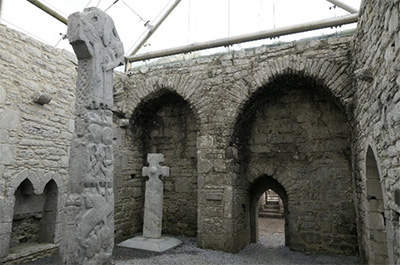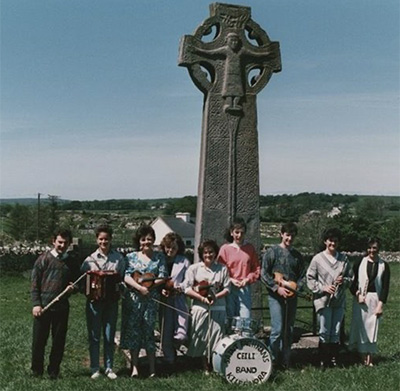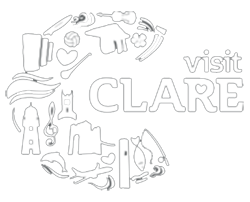Kilfenora Cathedral and Crosses
There’s no village on or near the Wild Atlantic Way that has such a range of historical artefacts as Kilfenora – which, due to its ancient cathedral, can actually lay claim to being the world’s smallest city! And it is famous for its group of ancient celtic crosses, more than in any other single place in Ireland.

The present cathedral building was completed in 1058 on the site of St Fachtnan’s 6th century monastery. The preceding building had been destroyed in 1055 by Murrough O’Brien, grandson of the famous Brian Boru, as part of a devastating cattle raid. Further work was needed in 1l00 after a bad fire. The re-built Cathedral was considered one of the finest churches in Ireland at the time, and you can still see some fine stone carvings and tombs that have survived the centuries.
The ‘Bishop of Kilfenora’ is the Pope!
The historic Kilfenora diocese, which corresponds to the ancient barony of Corcomroe, was the smallest in Ireland (13 parishes, and at one time 23 churches). Eventually its weak financial base led first to a merger with the monastic site of Kilmacduagh (near the Clare-Galway border), and subsequently the Catholic Church proposed incorporation with the Galway diocese. Local rejection of this proposal led to the compromise that the Bishop of Galway (to this day) serves as the Pope’s representative, and hence the Pope is officially regarded as the Bishop of Kilfenora in perpetuity. You can read about Kilfenora’s bishops here.
Remarkably the Cathedral was shared with the Anglican Church of Ireland – which had its own separate structure of dioceses – after the Reformation, and eventually the latter took over ownership, and a new Catholic church was built in the late 1800s. Both are named after St Fachtnan.
Particularly significant among the graves in the churchyard is that of Kitty Linnane, where each St. Patrick’s Day local musicians gather to play tunes in tribute to the Kilfenora Céilí Band’s famous band leader.
The roofed part of the cathedral is used for occasional Church of Ireland services. Its exceptional acoustics have also made it an excellent venue for concerts. It has preserved its remarkable wooden pews from the 1800s, including extremely rare examples of family enclosures. There are several other historic features, including its ancient baptismal font and the large ‘McDonough monument’ on one of the side walls.
The transept is covered by a steel and glass roof was erected in 2004 to protect the historic collection of stone crosses.
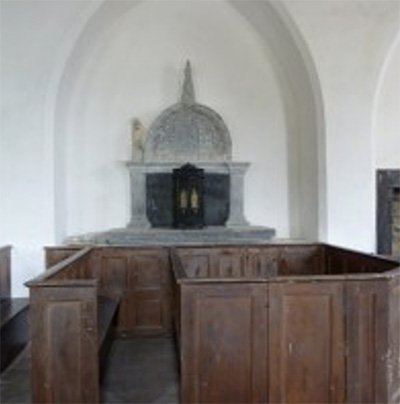
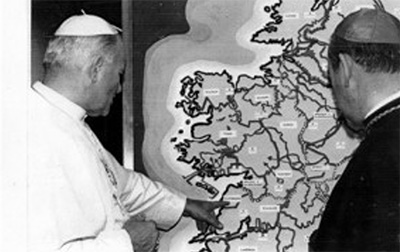
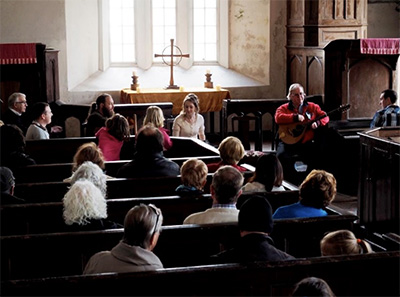
The High Crosses
Kilfenora is famous for its ‘seven crosses’, the earliest dating from the ninth century AD – an indication of its importance as a religious centre. Originally there were crosses north, south, east and west of the village, and others in the graveyard such as the beautiful ‘Doorty Cross’.
Most of these crosses can now be seen in the Cathedral transept – also known as ‘the Lady Chapel’ – protected by a glass and steel roof erected by the Office for Public Works.
The West Cross is still in situ in a field near the Cathedral. The South Cross was removed by a Protestant bishop in 1821 to his palace, and can now be seen in the Anglican Cathedral in Killaloe. The Kilfenora community hopes it will be returned to its home in due course!
You can read in detail about the individual crosses and their history here (scroll through the 9 pages).
